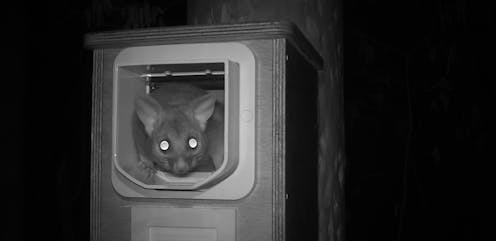the high-tech tools helping scientists save our wildlife
- Written by Darcy Watchorn, PhD Candidate, Deakin University

Around the world, Earth’s natural environments are being destroyed at a truly shocking scale. It means places animals need to shelter and breed, such as tree hollows[1], rock crevices[2] and reefs[3], are disappearing.
The only long-term way to protect these animals is to stop destroying their homes. But political resistance[4], financial interests[5] and other factors often work to prevent this. So scientists must get creative to try and hold off extinction in the short term.
One way they do this is to create artificial habitat structures. Our new research[6], released today, examines how ingenious, high-tech innovation is making some structures more effective.
But artificial habitats are not a silver bullet. Some can harm animals, and they can be used by developers to distract from the damage their projects cause.
What are artificial habitat structures?
Animals rely on specific environmental features to survive, grow, reproduce and sustain healthy populations. Artificial structures seek to replicate these habitats.
Some artificial homes provide habitat for just one species, while others benefit entire ecological communities.
They’ve been built for a huge variety of animals across the world, such as:
nests made from mud brick and aerated concrete for the shy albatross[9]
ceramic poles that provide a surface for spotted handfish[11] to lay eggs
textured tiles[12] attached to seawalls that provide habitat for up to 85 marine species.
How do new technologies help?
More recently, wildlife conservationists have partnered[13] with engineers and designers to incorporate new and exciting technologies into artificial habitat design.
For example, researchers in Queensland recently installed microchip-automated doors[14] on nest boxes for brushtail possums.
The doors opened only for microchipped possums as they came close, and most possums were trained to use them in about 11 days. Such technology may help to keep predators and other animals out of nest boxes provided for threatened species.
In New Zealand, small, native lizards hide from predatory house mice in the crevices of rock piles. Researchers used video game software[15] to visualise these 3D spaces and create “Goldilocks” rock piles - those with crevices big enough to let lizards in, but small enough to exclude mice.
3D printing to create artificial habitats is also becoming increasingly common.
Scientists have used a combination of computer simulation, augmented reality and 3D-printing to create artificial owl nests[16] that resemble termite mounds in trees.
And researchers and designers have created 3D-printed rock pools[17] and reefs[18] to provide habitat for sea life.
Read more: Urban owls are losing their homes. So we're 3D printing them new ones[19]
A 3D-printed, modular artificial reef structure designed by Alex Goad.It’s not all good news
Collaboration between scientists and engineers has enabled amazing new homes for wildlife, but there’s still lots of room for improvement[20].
In some instances, artificial habitats may be detrimental to an animal’s health. For example, they may get too hot[21] or be placed in areas with little food or lots of predators[22].
And artificial habitats can become ineffective[23] if not monitored and maintained.
Artificial habitat structures can also be used to greenwash[24] environmentally destructive projects, or to distract[25] from taking serious action on climate change and habitat loss.
Further, artificial habitat structures are often only feasible at small scales, and can be expensive to build, deploy and maintain.
If the root causes of species decline - including habitat destruction and climate change - aren’t addressed, artificial habitat structures will do little[26] to help wildlife in the long-term.
What next?
It’s great that conservationists can create high-tech homes for wildlife – but it would be better if they didn’t have to.
Despite the dwindling numbers of countless species, environmental damage continues apace.
Native forests are cut down[27] and rivers are dammed[28]. Ocean shorelines are turned into marinas or seawalls[29] and greenhouse gases are pumped into the atmosphere[30].
Such actions are the root cause of species decline.
We strongly encourage further collaboration between scientists and engineers to improve artificial habitat structures and help animal conservation. But as we help with one hand, we must stop destroying with the other.
Read more: Artificial refuges are a popular stopgap for habitat destruction, but the science isn't up to scratch[31]
References
- ^ tree hollows (doi.org)
- ^ rock crevices (onlinelibrary.wiley.com)
- ^ reefs (doi.org)
- ^ political resistance (theconversation.com)
- ^ financial interests (www.theguardian.com)
- ^ new research (esajournals.onlinelibrary.wiley.com)
- ^ beetles (link.springer.com)
- ^ seabirds (doi.org)
- ^ shy albatross (www.worldwildlife.org)
- ^ seahorses (theconversation.com)
- ^ spotted handfish (www.abc.net.au)
- ^ tiles (www.livingseawalls.com.au)
- ^ partnered (www.sciencedirect.com)
- ^ microchip-automated doors (doi.org)
- ^ video game software (doi.org)
- ^ artificial owl nests (doi.org)
- ^ rock pools (www.livingseawalls.com.au)
- ^ reefs (www.reefdesignlab.com)
- ^ Urban owls are losing their homes. So we're 3D printing them new ones (theconversation.com)
- ^ for improvement (onlinelibrary.wiley.com)
- ^ too hot (www.sciencedirect.com)
- ^ lots of predators (doi.org)
- ^ become ineffective (ttu-ir.tdl.org)
- ^ greenwash (doi.org)
- ^ distract (www.smh.com.au)
- ^ do little (theconversation.com)
- ^ cut down (theconversation.com)
- ^ dammed (cdnsciencepub.com)
- ^ marinas or seawalls (www.nature.com)
- ^ pumped into the atmosphere (theconversation.com)
- ^ Artificial refuges are a popular stopgap for habitat destruction, but the science isn't up to scratch (theconversation.com)

















